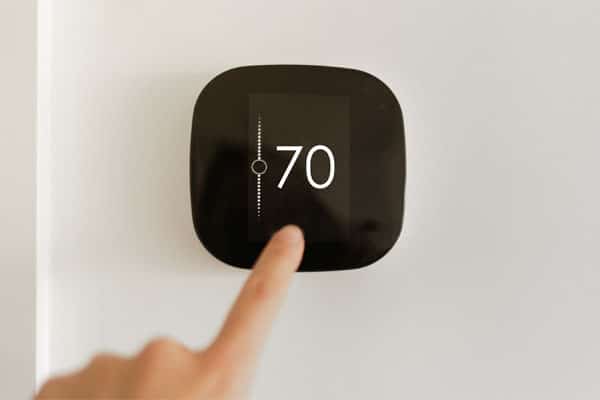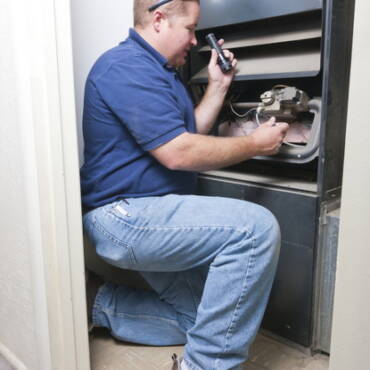Maintaining home comfort doesn’t have to be complicated. With a little effort and some knowledge, optimizing thermostat settings can save you money on energy costs while keeping you and your family comfortable. In this blog post, we’ll take a look at the best ways to optimize thermostat settings, from traditional thermostats to smart thermostats, as well as discuss the importance of consulting a professional HVAC technician from Sherlock for installation and maintenance. Read on to learn how to master home comfort like a pro!
Thermostat Basics
To optimize thermostat settings, it’s important to first understand the basics of how they work. A thermostat is a device that regulates and maintains the temperature in your home. It is the control center for your heating, ventilation, and air conditioning (HVAC) system.
At its core, a thermostat detects the current temperature of your home and compares it to the desired temperature you have set. If the current temperature is higher than the desired temperature, the thermostat sends a signal to the HVAC system to cool the air. If the current temperature is lower than the desired temperature, the thermostat signals the HVAC system to heat the air.
Understanding this process is crucial for achieving energy savings and maintaining home temperature comfort. By setting the thermostat to a higher temperature during the summer or a lower temperature during the winter when you are away from home, you can save on energy costs. Additionally, programmable thermostats allow you to schedule temperature changes throughout the day, ensuring that your home is comfortable when you need it to be and saving energy when you don’t.
With a firm grasp on the basics, you can now dive deeper into the pros and cons of traditional thermostats, as well as explore the world of smart thermostats. Let’s continue our journey to thermostat mastery!
Traditional Thermostats v. Smart Thermostats
Traditional thermostats have been the go-to option for controlling home temperature for many years. They are simple, easy to use, and often less expensive than their smart thermostat counterparts. However, they do come with their own set of pros and cons.
One of the major benefits of traditional thermostats is their simplicity. They typically have basic controls and settings, making them easy for anyone to operate. You can manually adjust the temperature as needed and set it to your desired comfort level. Additionally, traditional thermostats are generally more affordable, making them a cost-effective option for homeowners on a budget.
On the downside, traditional thermostats lack advanced features and customization options. They do not have the ability to learn your habits or adjust temperature settings automatically. This means you have to manually adjust the thermostat throughout the day to maintain a comfortable temperature. This can be inconvenient, especially if you have a busy schedule.
Furthermore, traditional thermostats may not be as energy-efficient as smart thermostats. They cannot adapt to changes in weather or occupancy, potentially leading to wasted energy and higher utility bills. They also lack features like programmable schedules, which can help you save energy and money in the long run.
In summary, traditional thermostats are a simple and cost-effective option for controlling home temperature. They are easy to use but lack the advanced features and energy-saving capabilities of smart thermostats. Consider your specific needs and budget when deciding which type of thermostat is best for your home. Get in touch with the AC specialists at Sherlock for professional guidance.
How Smart Thermostats Work
Smart thermostats are revolutionizing home temperature control with their advanced features and intelligent technology. Unlike traditional thermostats, which rely on manual adjustments, smart thermostats use Wi-Fi connectivity and sensors to optimize your home’s temperature settings automatically.
The key feature of a smart thermostat is its ability to learn your preferences and habits over time. It collects data on your daily routines, such as when you wake up, leave for work, and return home. With this information, it can create personalized temperature schedules that maximize comfort and energy efficiency.
Smart thermostats also have the ability to adapt to changing weather conditions. For example, if a heatwave is approaching, the smart thermostat can anticipate the rising temperatures and adjust the cooling settings accordingly. This proactive approach ensures that your home remains comfortable without wasting energy or money.
In addition to their adaptive capabilities, smart thermostats offer convenient control options. Most smart thermostats can be controlled remotely through smartphone apps. This means you can adjust the temperature from anywhere, whether you’re at work, on vacation, or just relaxing in another room. Some models even have voice control features, allowing you to change settings with simple voice commands.
Furthermore, smart thermostats often come with energy usage reports and tips to help you save even more on your utility bills. These reports provide insights into your energy consumption patterns, enabling you to make informed decisions about your thermostat settings and overall energy usage.
Overall, smart thermostats provide an advanced and intuitive approach to home temperature control. Their ability to learn, adapt, and provide convenient control options makes them a valuable investment for optimizing comfort and energy savings in your home.
The Benefits of Upgrading to a Smart Thermostat
If you’re still on the fence about upgrading to a smart thermostat, let’s take a look at some of the benefits that might just convince you to make the switch. One of the biggest advantages of upgrading to a smart thermostat is the energy savings it can provide. By using advanced sensors and algorithms, smart thermostats can optimize your heating and cooling schedules based on your preferences and habits. This means you won’t have to constantly adjust the temperature manually throughout the day, saving you time and effort.
In addition to saving you time, smart thermostats can also save you money. With their ability to learn and adapt to your schedule, they can automatically adjust the temperature when you’re away from home, reducing unnecessary energy consumption. Some smart thermostats even provide detailed energy usage reports, allowing you to track your energy consumption and identify areas for further savings.
Another benefit of smart thermostats is the convenience they offer. Most models can be controlled remotely through smartphone apps, giving you the flexibility to adjust the temperature from anywhere. Imagine coming home to a perfectly comfortable house after a long day at work, without having to lift a finger!
Smart thermostats also offer a level of customization that traditional thermostats simply can’t match. With features like geofencing, which uses your smartphone’s location to adjust the temperature when you leave or return home, and integration with smart home devices, such as voice assistants or occupancy sensors, you can create a truly personalized and automated home temperature system.
In summary, upgrading to a smart thermostat offers numerous benefits, including energy savings, cost savings, convenience, and customization. If you’re looking to optimize your home comfort and take control of your energy usage, a smart thermostat is definitely worth considering. Give Sherlock Heating and Air a call to get answers to any questions you might have.
Optimizing Your Thermostat Settings for Energy Savings
Now that you have a good understanding of how thermostats work and the benefits of both traditional and smart thermostats, it’s time to focus on optimizing your thermostat settings for maximum energy savings. Here are some tips to help you get started.
1. Take advantage of programmable features: If you have a programmable thermostat, make sure to utilize its scheduling capabilities. Set the temperature higher or lower (depending on the season) when you’re away from home or sleeping. This can significantly reduce your energy consumption without sacrificing comfort.
2. Utilize setback temperature: Consider setting a setback temperature for times when you’re away from home for an extended period, like a vacation. This way, you can save energy by not heating or cooling your home unnecessarily.
3. Find the ideal temperature: Experiment with different temperature settings to find the perfect balance between comfort and energy savings. Just a few degrees difference can make a big impact on your energy bill.
4. Make use of natural heating and cooling: Take advantage of natural heat sources during the winter, such as sunlight, by opening curtains during the day. In the summer, keep curtains and blinds closed during the hottest parts of the day to prevent heat from entering your home.
5. Regularly maintain your HVAC system: Clean or replace air filters as recommended to ensure your system is running efficiently. A well-maintained HVAC system will not only save energy but also prolong the lifespan of your equipment.
Remember, optimizing your thermostat settings is an ongoing process. It may take some time to find the settings that work best for you and your family. Don’t be afraid to make adjustments as needed. With a little effort and attention to detail, you can achieve optimal energy savings while keeping your home comfortable year-round.
Tips for Maximizing Comfort with Your Thermostat
Now that you have your thermostat set up and ready to go, it’s time to focus on maximizing your comfort levels. After all, a comfortable home is a happy home! Here are some tips to help you make the most out of your thermostat settings and create a cozy environment all year round.
1. Use fan settings wisely: Most thermostats have fan settings that allow you to control the airflow in your home. During the summer, setting your fan to “Auto” can help distribute cool air more effectively. In the winter, setting it to “On” can circulate warm air throughout your home. Experiment with these settings to find what works best for you.
2. Don’t ignore humidity levels: Humidity plays a significant role in how comfortable your home feels. During the summer months, aim for a humidity level between 30% to 50% to prevent that sticky feeling. In the winter, try to keep humidity levels around 30% to 40% to avoid dryness. Some smart thermostats even have built-in humidity sensors to help you maintain the ideal levels.
3. Zone your home: If you have a larger home with multiple floors or rooms, consider using zoning features if available. This allows you to set different temperatures for different areas of your home, ensuring everyone’s comfort preferences are met.
4. Utilize temperature presets: Many smart thermostats offer the ability to save temperature presets for different scenarios, such as “Home,” “Away,” and “Sleep.” Take advantage of these presets to quickly and easily adjust the temperature to your desired comfort level with just a few taps.
5. Take advantage of auxiliary devices: Smart thermostats often integrate with other smart home devices, such as smart blinds or ceiling fans. By coordinating these devices with your thermostat, you can maximize comfort and energy efficiency. For example, when your thermostat senses that the temperature is getting too high, it can automatically lower your blinds to block out the sun or activate your ceiling fans to circulate cool air.
By implementing these tips, you’ll be well on your way to creating the perfect temperature and comfort level for your home. Remember, it’s all about finding the settings that work best for you and your family’s preferences. So go ahead, tweak those thermostat settings and enjoy the cozy haven you’ve created!
Why Professional Installation and Maintenance is Important
When it comes to optimizing your thermostat settings for maximum energy savings and comfort, it’s crucial to enlist the help of a professional HVAC technician for installation and maintenance. While it may be tempting to tackle the job yourself, professional installation ensures that your thermostat is set up correctly and functioning at its best.
Professional installation provides several benefits. First and foremost, it guarantees that your thermostat is properly calibrated and programmed to your specific heating and cooling system. This ensures accurate temperature readings and efficient operation. Additionally, an HVAC technician can assess your home’s unique heating and cooling needs, recommending the best thermostat model and placement for optimal performance.
Maintenance is another key aspect of professional service. Regular maintenance visits by an HVAC technician will help keep your thermostat and HVAC system running smoothly and efficiently. They can check for any issues or malfunctions, clean and calibrate components, and make necessary adjustments to maximize energy savings. By catching and addressing potential problems early on, you can avoid costly repairs down the line.
Overall, professional installation and maintenance of your thermostat not only ensures its proper functioning but also protects your investment in your heating and cooling system. Don’t leave it to chance or DIY guesswork – trust the experts at Sherlock to handle your thermostat installation and maintenance needs. With our expertise and attention to detail, you can enjoy optimal comfort and energy savings year-round.
Whether you require installation, repair, or maintenance, our technicians will assist you with top-quality service at any time of the day or night. Take comfort in knowing your indoor air quality is the best it can be with MOE heating & cooling services Ontario's solution for heating, air conditioning, and ventilation that’s cooler than the rest.
Contact us to schedule a visit. Our qualified team of technicians, are always ready to help you and guide you for heating and cooling issues. Weather you want to replace an old furnace or install a brand new air conditioner, we are here to help you. Our main office is at Kitchener but we can service most of Ontario's cities
Source link



